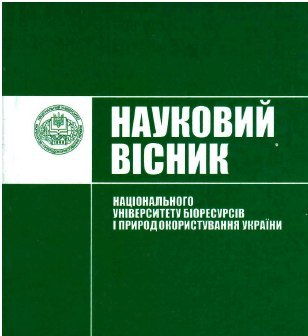German borrowings in the Ukrainian musical terminology
DOI:
https://doi.org/10.31548/philolog0(263).2017.065%20-%2074Abstract
The article is dedicated to the issue of the German language borrowings in the Ukrainian musical terminology. The research actuality is caused by the need of studying the peculiarities of lexical, grammatical and spelling adoption of the terms borrowed from the German language in the Ukrainian musical terminology.
The aim of the article is the thematic analysis of the German borrowings, tracing the ways of their adaptation to the contemporary Ukrainian language standards.
The following research methods and modes have been used to achieve this aim: descriptive and typological (for the German language borrowings detection and systematization), the dictionary definition analysis method (for the semantic structure clarification), the comparison mode (for detecting the specific features of the analyzed units), the quantitative calculations methods (for the German language borrowings numeric characteristics).
There has been the following research source basis: the lexicographical work by Yuriy Yutsevych “Music. Dictionary-Reference Book, the «Dictionary of the musical terminology» (Project, «The musical dictionary by Zynoviy Lys’ko” and the Dictionary of the Ukrainian language in 11 volumes have also been used for comparison.
65 terms borrowed from the German language have been detected in the musical terminology of the Ukrainian language. They represent different thematic groups: the musical instruments names (al’thorn (althorn), byuhel’horn (bugelhorn), aura (aura) sakshorn (saxhorn), flyuhelhorn (flugelhorn) etc.), the musical instruments details and devices names (blokfleyta (block flute), val’tsi (rollers), ventyl’ (mute), hryf (finger board) etc.), the professions, occupations, roles names (baletmeyster (ballet-master), wunderkind (child prodigy), kapelmeister (bandmaster), kontsertmeyster (accompanist) etc.), the musical pieces and genres names (kasatsiya (reversion), kontsertstyuk (konzerstuck), lendler (landler), lid (lead), tirol’yen (Tyrolienne), tush (flourish) etc.), the processes, metrical rhythmical notions, sounds and musical systems properties names (auftakt (upbeat), hastrol’ (concert tour), heneral-bas (general bass), klavir (clavier) etc.), the melody decorations names (forshlag (grace note), shleyfer (appogiatur), the directions names (doych-rok (German rock)), the groups names (trupa (troupe)).
The following changes occur during the musical terms borrowings:
- 1. The semantics narrowing occur. Only terminological meanings are transferred into the Ukrainian language, whereas the internal shape of these words is lost.
2. The term structure is changed. The derivative character of such terms bases can be defined only after examining the word etymology.
3. The borrowed terms are adapted to the phonetic and spelling standards of the Ukrainian language.
4. The grammar form of the German language borrowing changes.
5. The terms borrowed from the German language take part in the Ukrainian terms formation. A significant number of the compound terms has been formed.
In our opinion some borrowings from the German language should be replaced with their Ukrainian counterparts: auftakt (upbeat) – zatakt, dempfer (damper) – hlushnyk, mundshtuk (mouthpiece) – hubnyk.
Thus, the Ukrainian musical terminology have adopted the considerable number of the German terms – international terms. They nominate the important notions of the musical science. The main ways of the German language borrowings adaptation are the following: lexical translation, grammatical adjustment, spelling and phonetic arrangement of these lexemes.
References
Bulyk-Verkhola, S. Z. (2006). Zapozychennia v ukrainskii muzychnii terminolohii [Borrowings in the Ukrainian musical terminology] // Visnyk Natsionalnoho universytetu «Lvivska politekhnika». Seriia: «Problemy ukrainskoi terminolohii». – Lviv: Vydavnytstvo Lvivskoi politekhniky, № 559, 252–254.
Hanych, D., Oliinyk I. (1985). Slovnyk linhvistychnykh terminiv [The linguistic terms dictionary]. – K.: Vyshcha shkola, 96.
Zubkov, M. (2012). Do problemy unormuvannia zapozychen [To the issue of the borrowings standardization] // Problemy ukrainskoi terminolohii: zb. nauk. pr. – Lviv: Vydavnytstvo Lvivskoi politekhniky, 3–5.
Kochan, I. (1996). Inshomovni slova v suchasnii tekhnichnii terminolohii [Foreign languages words in the contemporary technical terminology] // Ukrainskyi pravopys i naukova terminolohiia: istoriia, kontseptsii ta realii sohodennia: materialy zasidan Movoznavchoi komisii ta Komisii vsesvitnoi literatury NTSh u Lvovi 1994–1995 rokiv / red. O. Kupchynskyi. – L.: [b.v.], 129–134.
Lysko, Z. (1930). Muzychnyi slovnyk [The musical dictionary]. – Stryi: Vydavnytstvo Muzychnoho Tovarystva im. M. Lysenka, filiia v Stryiu, 1933, 165.
Sekunda, T. (1930). Pryntsypy skladannia ukrainskoi tekhnichnoi terminolohii [The principles of the Ukrainian technical terminology composition] // Visnyk Instytutu ukrainskoi naukovoi movy. – K., 1930, Vyp. 2, 11–21.
Slovnyk muzychnoi terminolohii (Proiekt). (1930). [The musical terminology dictionary (Project)]. – Kharkiv – Kyiv: Derzhavne vydavnytstvo Ukrainy, 1930, 135.
Slovnyk ukrainskoi movy: V 11-ty tomakh. (1970–1980). [The dictionary of the Ukrainian language: in 11 volumes.]. – K.: Naukova dumka, T. І–ХІ.
Yutsevych, Iu. (2003). Muzyka. Slovnyk-dovidnyk [Music. Dictionary-Reference Book]. – Ternopil: Bohdan, 352.
Downloads
Published
Issue
Section
License
Relationship between right holders and users shall be governed by the terms of the license Creative Commons Attribution – non-commercial – Distribution On Same Conditions 4.0 international (CC BY-NC-SA 4.0):https://creativecommons.org/licenses/by-nc-sa/4.0/deed.uk
Authors who publish with this journal agree to the following terms:
- Authors retain copyright and grant the journal right of first publication with the work simultaneously licensed under a Creative Commons Attribution License that allows others to share the work with an acknowledgement of the work's authorship and initial publication in this journal.
- Authors are able to enter into separate, additional contractual arrangements for the non-exclusive distribution of the journal's published version of the work (e.g., post it to an institutional repository or publish it in a book), with an acknowledgement of its initial publication in this journal.
- Authors are permitted and encouraged to post their work online (e.g., in institutional repositories or on their website) prior to and during the submission process, as it can lead to productive exchanges, as well as earlier and greater citation of published work (See The Effect of Open Access).

